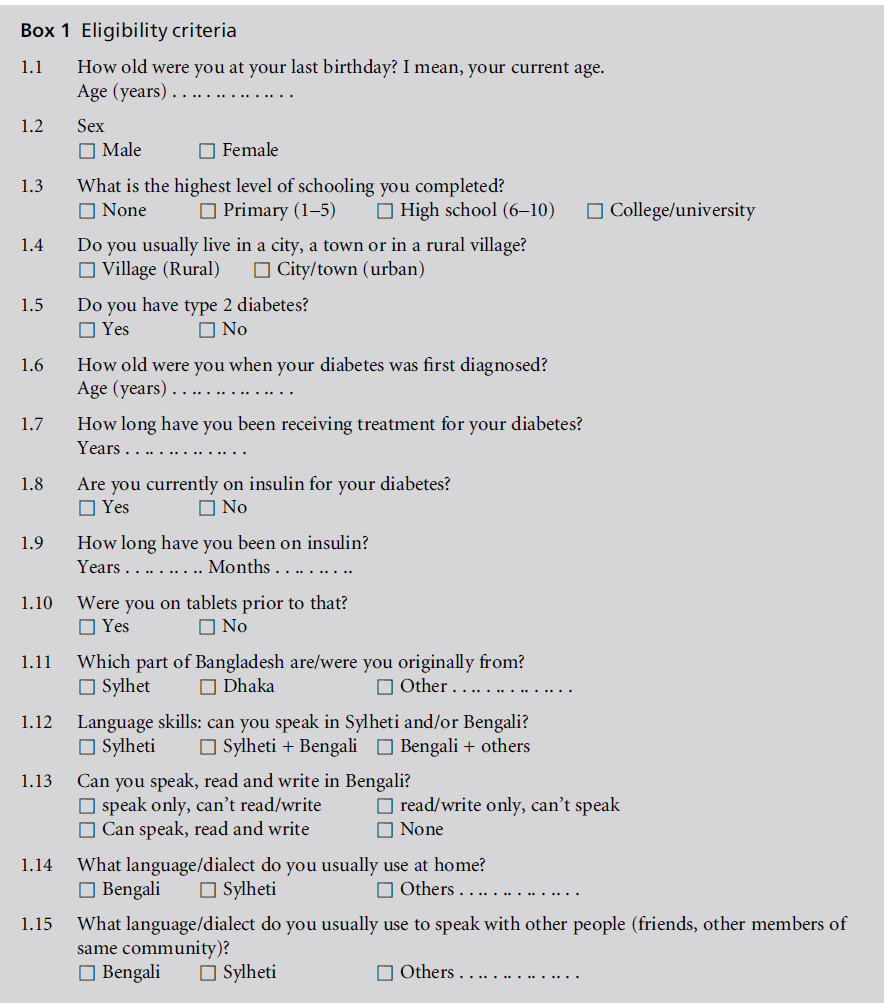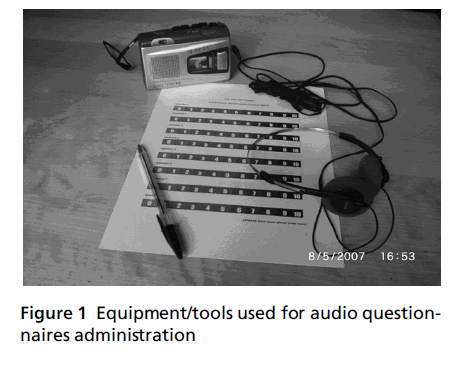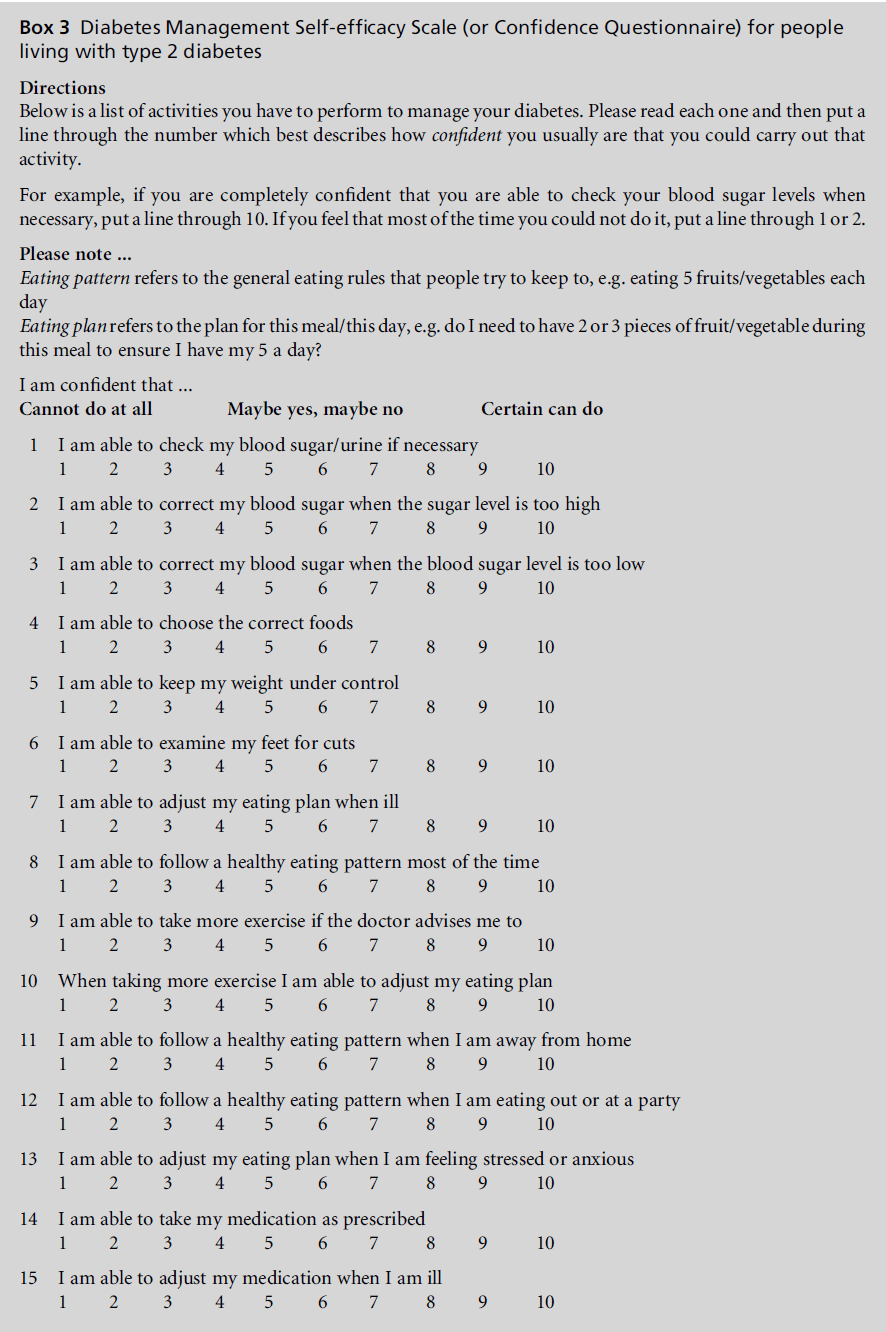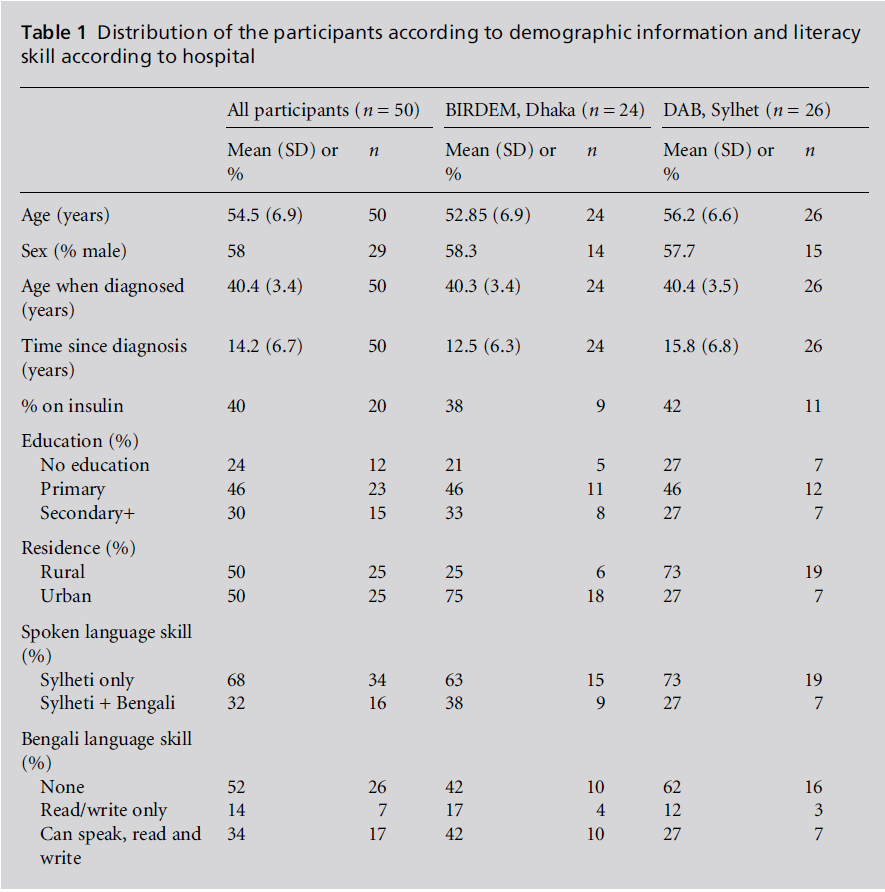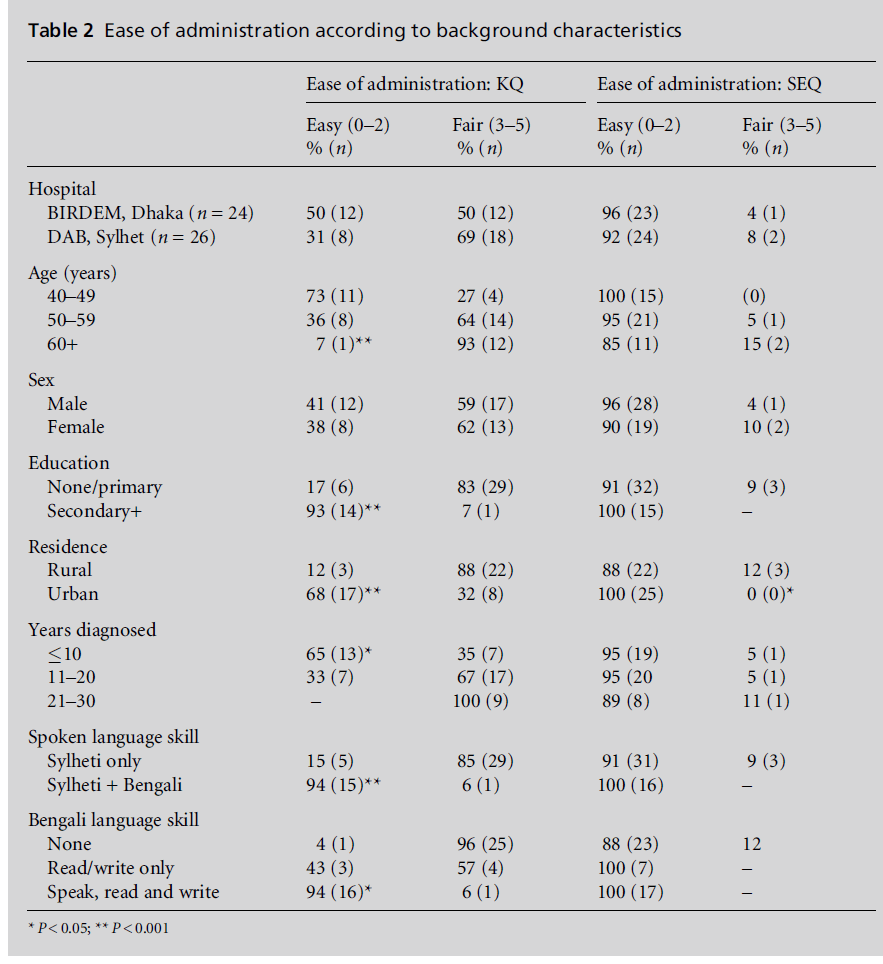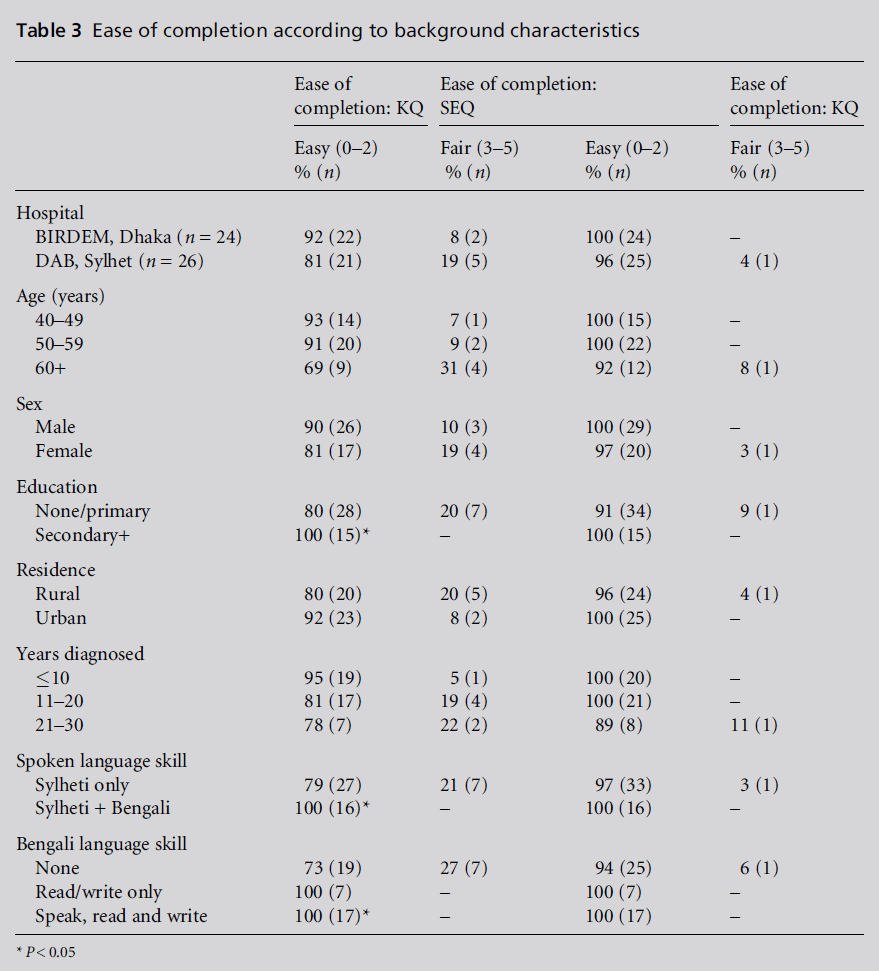What is known on this subject
• Previous research has demonstrated difficulties in data collection in populations with low literacy levels.
• Non-literate individuals are often excluded from research, although the use of certain methods can
increase participation rates.
• Audio methods have been shown to be acceptable for data collection, for example in order to measure
knowledge and self-care in individuals with type 2 diabetes.
What this paper adds
• Audio methods of data collection, previously developed in the UK for use with South Asians with type 2
diabetes and low literacy rates, were found to be acceptable in two populations in Bangladesh.
• Colour-shaded Likert-type scales were preferred to multiple choice questionnaires.
• Using audio methods of questionnaire delivery ensures confidentiality whilst at the same time encouraging
individuals with low literacy levels to participate in research.
Keywords
instrument development, qualitative
methods, South Asian, type 2 diabetes
Introduction
Type 2 diabetes is a significant health problem in
South Asians, both in the UK and in countries such
as Bangladesh, India and Pakistan (Hussain et al, 2005).
In the UK, healthcare delivery as well as health services
research in South Asian groups is often hampered by
cultural and communication difficulties such as the
lack of a common language or understanding (Collins
and Johnson, 2007; Lloyd et al, 2006, 2008a,b). This is
particularly evident with regard to services provided
for diabetes, where recommended standards of care
involve self-management of the condition, supported
by diabetes education and other interventions delivered
by a range of healthcare professionals (Department of
Health, 2001). Communication problems may occur
in both health service delivery and research, and in
both settings the collection and interpretation of selfreported
data may be problematic (Hunt and Bhopal,
2003, 2004). Individuals from minority ethnic groups
are often excluded from research on the grounds of
language or literacy difficulties, and so their views are
often marginalised (Picker Institute, 2006; Lloyd et al,
2008c).
There has been increased interest in recent years
in the experiences of migrants with regard to health
services delivery in the UK. Research in this area has
used a range of methods, although qualitative techniques
have become more popular as a useful way of
obtaining the views and opinions of migrant communities
(Greenhalgh et al, 1998; Rhodes et al, 2003;
Sunsoa, 2008). Increasing participation rates in clinical
trials appears to remain a significant challenge (Hussain-
Gambles et al, 2005). A recent large investigation of
South Asians with diabetes attending primary and
secondary care services in the UK (Bellary et al, 2008)
clearly demonstrated some of these problems. Although
recruitment per se was not particularly problematic,
serious difficulties in implementing self-complete questionnaireswere
encountered, despite the availability of
translated questionnaires (Lloyd et al, 2006). Given
the high rates of non-literacy and the common reliance
on relatives to respond to information requests
on the patient’s behalf, a follow-up study was designed
to develop alternative data collection methods (Lloyd
et al, 2008b,c). In this latter qualitative study, two
groups of adults with type 2 diabetes, whose main
language was only spoken and who did not have an
agreed written form, participated in a series of focus
groups during which both the content and form of
delivery of two survey instruments designed to measure
aspects of diabetes self-care were evaluated and adapted.
The results of this research, where four alternative
methods of data collection were compared, demonstrated
that, for the Bengali study population, independent
audio data collection was the preferred mode (Lloyd et al, 2008b). This entailed the participants
completing the questionnaires by listening to audio
versions of the questionnaires and completing colourcoded
answer sheets independently. All the Bengali
participants preferred this method over and above
using traditional paper and pencil methods or assisted
data collection methods. In order to further test out
this method, a small study was undertaken with individuals
with type 2 diabetes living in two areas of
Bangladesh where literacy problems in data collection
also arise.
Methods
The study was conducted between March 2007 and
July 2007. We purposefully selected two sites for data
collection, one in urban Dhaka and the other in suburban
Sylhet, with the aim of maximising the response
rate. The two specific sites of data collection were the
Bangladesh Institute of Research and Rehabilitation in
Diabetes, Endocrine andMetabolic Disorders (BIRDEM)
Hospital at Dhaka, and the Diabetic Association of
Bangladesh (DAB) Hospital at Sylhet. Individuals who
spoke Sylheti and were attending either the outpatient
department of BIRDEM Hospital, Dhaka, or the DAB
Hospital, Sylhet, for consultation for type 2 diabetes
were approached by one of the investigators (TR) and
invited to participate in the study. An attempt was
made to recruit an equal number of participants from
each hospital.
In both settings, consecutive attendees in the diabetes
outpatient department were approached. Medical officers
or resident physicians assisted with recruitment
by allowing the researcher to sit in on consultations,
during which time the study could be explained, and
the patient invited to participate. The original protocol
was approved by the East Birmingham Local Research
Ethics Committee. The modified protocol for undertaking
the study in Bangladesh was reviewed by project
team members prior to obtaining ethical approval to
carry out the study, from both the BIRDEM and DAB
hospital authorities.
A demographic form used in the previous study
(Lloyd et al, 2008b) was modified for use in Bangladesh
and used to assess eligibility (see Box 1). All participants
had type 2 diabetes, but eligibility was not linked
to the type of treatment they received. Consequently,
participants could be on any treatment regime. Assessment
of duration of diabetes was derived from
answers to the single item concerning how long the
participants had been treated for the condition.
Those who agreed to take part were invited to move
to a separate consulting room in order to test out the
audio method of data collection. Female participants
were accompanied by either a female member of hospital staff or the person attending the hospital with
them. Audio consent was taken from each participant
using an audio-cassette recorder and a copy of the
audio-recorded consent given. After being given a
further explanation of the process of audio data collection
and a brief demonstration on how to use the
audio equipment, pre-recorded audio questionnaires
were then self-administered using a portable audiocassette
player and a headphone as shown in Figure 1.
Respondents listened to each question and provided
answers using the appropriate answer sheets (see Figure
1). This technique ensures a completely standardised
process, with respondents hearing all the questions in
the same way.
Box 1: Eligibility criteria.
Figure 1: Equipment/tools used for audio questionnaires
administration.
Two questionnaires were tested: the Revised Diabetes
Knowledge Scale (RDKS; Fitzgerald et al, 1998;
see Box 2) and the Diabetes Management Self-Efficacy
Scale (DMSES) (Sturt and Hearnshaw, 2003; see Box
3). The RDKS is an adapted version of the Michigan
Diabetes Knowledge Scale which was revised because
certain terms were inappropriate for use in populations
outside the USA. The RDKS consists of 20
multiple choice questions including items on diet,
blood glucose control, exercise, medication taking and
complications. Participants were asked to indicate their
preferred answer to each question on a numbered score
sheet. The DMSES has recently been revalidated for
the measurement of diabetes management selfefficacy
in UK populations. It consists of 15 items on
confidence in performing various aspects of self-care,
including medication taking, diet, blood glucose
monitoring and exercising. A colour-shaded Likerttype
scale (0–10) was used, in order for the respondents
to indicate how confident they were in
performing each aspect of diabetes self-care. Lighter
shading and lower numbers indicated lower levels of
confidence, whereas darker shading and higher numbers
indicated higher levels of confidence in self-care.
Prior to this study, audio versions of both questionnaires
were developed in Sylheti and evaluated
through consultation with a group of Sylheti-speaking
individuals with type 2 diabetes attending diabetes
outpatient departments in Birmingham, UK (Lloyd
et al, 2008b).
Following questionnaire completion, each participant
took part in a brief interview with the researcher,
who completed an evaluation proforma for each
questionnaire. The evaluation proforma, developed
during a previous study (Lloyd et al, 2008b), was used
to assess participants’ opinions on the administration
and completion of audio-assisted methods. Questions
on the proforma included ones on the ease of administration
and ease of completion, with answers on a
colour-shaded Likert-type scale of 0 (very easy) to 10
(very hard or difficult). Ease of administration was
measured by responses to the question ‘did the participant
find it easy or hard to understand the items on
the questionnaire?’. Ease of completion was recorded
in a similar way, measured by the response to the
question ‘did the participant find it easy or hard to
complete the questionnaires?’. For the analysis, responses
on this scale were collapsed into four groups:
easy (0–2), fair (3–5), fairly difficult (6–8) and difficult
(9–10). Participants were also asked to indicate which
questions or particular terms they found unclear, if
any; whether they preferred one questionnaire to the
other and if so the reasons for this. The time taken by
each participant to complete each questionnaire was
also recorded.
Results
A total of 58 patients, 29 from each hospital, were
approached to take part. Fifty participants (BIRDEM:
24; DAB Sylhet: 26) who fulfilled the study selection
criteria participated in the study, giving response rates
of 83% and 90%, respectively (see Table 1).
Table 1 shows a number of key characteristics of the
study population. The mean age of the sample was 55
years, and this did not differ significantly between the
two centres. The mean age at diagnosis of diabetes was
40 years, with 40% of all participants reporting that
they were currently on insulin for their diabetes. All
those currently taking insulin reported taking oral
medications prior to insulin. Somewhat more men
than women took part in the study, with 58% of
participants in both centres being men. As the table
shows, a slightly greater proportion of participants
from the DAB Sylhet had received no education
compared to those from the BIRDEM. Whereas nearly
three-quarters of those attending the DAB Sylhet
described living in a rural environment, only onequarter
of those attending the BIRDEM did so. A high
proportion of participants from both centres spoke
only Sylheti, and approximately half were not able to
read or write Bengali.
Ease of administration
Box 2: Revised Michigan Diabetes Knowledge Questionnaire.
Box 3: Diabetes Management Self-efficacy Scale (or Confidence Questionnaire) for people
living with type 2 diabetes.
Table 1: Distribution of the participants according to demographic information and literacy
skill according to hospital.
Table 2: Ease of administration according to background characteristics.
Table 3:Ease of completion according to background characteristics.
Overall, study participants did not report any difficulties
understanding the terms used in either of the
questionnaires. A comparison of responses according
to background characteristics is shown in Table 2.
There were no significant differences observed in
response levels for either questionnaire in terms of
sex or hospital attended. Younger participants (age
group 30–39 years) found the knowledge questionnaire
easier to understand than older participants (age
group 60+ years; P = 0.002). Additionally, ease of
understanding the knowledge questionnaire was significantly
associated with participants’ level of education,
place of residence, level of spoken language
skill and level of written language skill. There was no
significant difference observed in the level of understanding
of the self-efficacy questionnaire except with
regard to place of residence, with those living in urban
areas more likely to report a greater ease of understanding
of the questionnaire compared to participants
living in rural areas (P < 0.05; see Table 2).
Ease of completion
Participants did not report any problems in completing
the questionnaires. Table 3 shows a comparison
of responses according to background characteristics in terms of ease of completion for the knowledge
questionnaire (KQ) and self-efficacy questionnaire
(SEQ). There was no significant difference observed
in response level for either questionnaire according to
hospital, age, sex or place of residence. Individuals who
reported finding the knowledge questionnaire easier
to complete had a higher level of education and were
more likely to speak, read and write both Sylheti and
Bengali. There were no significant differences observed
in ease of completion of the self-efficacy questionnaire
when compared with the same parameters, for example,
level of education, language skills (see Table 3).
A preference for one questionnaire over the other
was indicated by participants at both centres, although
this was more pronounced at the DAB Sylhet hospital,
with 81% of these participants preferring the selfefficacy
questionnaire compared to 58% of the participants
from BIRDEM. An overwhelming majority found the self-efficacy questionnaire easier to complete
compared to the knowledge questionnaire (DAB
Sylhet 96%; BIRDEM 100%). Those with lower levels
of education were more likely to report a preference
for the self-efficacy questionnaire; 83% of those with
no education or primary-level education reported a
preference for this questionnaire compared with 40%
of those with secondary-level or higher education
(P < 0.001). Those who lived in rural areas were also
significantly more likely to report a preference for the
self-efficacy questionnaire (84% versus 56% for those
from urban areas).
The mean time taken to complete the knowledge
questionnaire and the self-efficacy questionnaire was
26.62 (�4.17) minutes and 14.90 (�2.24) minutes
respectively. Non-literate and less educated participants
took more time to complete both questionnaires.
Participants with higher levels of education also displayed greater confidence levelswhile using the
audio methods of data collection compared to those
with lower levels of education.
Discussion
This study has shown that it is possible to administer
self-completed questionnaires in populations where
literacy levels are low, in order to establish levels of
knowledge and self-efficacy for diabetes self-care.
Rates of diabetes in Bangladesh are increasing and
pose a serious public health problem. Ways of improving
access to information in order to provide high standards of care are essential. Approximately onethird
of the population in Bangladesh has received no
formal education, with illiteracy levels highest in the
Sylhet region and among women (National Institute
of Population Research and Training, 2008). The majority
of those who have received some education have
not gone beyond primary level. The use of alternative
methods of data collection in areas where literacy levels
are low can help to improve both participation rates in
research and, more generally, in terms of obtaining
the views of individuals who are often excluded from
participating fully in their healthcare.
The use of audio methods of data collection was
seen as completely acceptable by those who participated
in the study, with the majority of individuals reporting no difficulties with questionnaire completion.
However, some differences in ease of administration
and completion for the two questionnaires were observed.
The self-efficacy questionnaire was found to be
easier to understand and easier to complete compared
to the knowledge questionnaire. It also tookmuch less
time to complete. When specifically asked for a preferred
questionnaire, the majority indicated a preference
for the self-efficacy questionnaire, which may be
perceived as less threatening than the knowledge
questionnaire.
Individuals who reported finding the knowledge
questionnaire easy to complete had a higher level of
education and were more likely to speak both Sylheti and Bengali compared to those who found this questionnaire
more difficult. These differences were not
observed for the self-efficacy questionnaire, and nearly
all participants found this easy to complete. This may
be because this questionnaire records felt ability or
perceived confidence in performing practical tasks
associated with diabetes self-management; it does not
formally explore the level of diabetes knowledge. Our
previous work also indicated that the Sylheti men
preferred the self-efficacy questionnaire over the
knowledge questionnaire (Lloyd et al, 2008b). In this
previous research many of our participants were concerned
about getting the knowledge questions right,
even when they were assured that the reason for consulting them was to ensure that the content and
form of delivery were appropriate, rather than to test
their knowledge.
The self-efficacy questionnaire is likely to be less
challenging compared to the knowledge questionnaire
when using an audio version, as there are no correct
answers and responses are recorded on a colour-shaded
Likert-type scale. Conversely, the design of the knowledge
questionnaire requires respondents to remember
four alternative answers to each question, and there
are correct and incorrect answers. This may be perceived
as much more threatening compared to the self-efficacy
questionnaire.
The knowledge questionnaire took, on average,
nearly 30 minutes to complete, whereas the self-efficacy
questionnaire took approximately half this time. Although
participants were happy to take the time to
complete these questionnaires, this may not be practical
in a busy clinic setting where a large number of patients
is waiting to be seen. It may be more appropriate to
complete these questionnaires prior to diabetes education
sessions, so that the data inform the content
or focus of the session. Using an independent audio
method to collect data ensures confidentiality and would
encourage thosewith poorer literacy skills to complete
questionnaires.
There are limitations to these data, including the
small sample size. However, this was an exploratory
study in which we wanted to further develop our audio
methods of questionnaire administration, rather than
come to any firm conclusions with regard to the level
of diabetes knowledge or self-efficacy in this population.
This study has demonstrated the usefulness of
this method of data collection. It is clearly an acceptable
mode and easy to administer, with little difficulty
experienced from the perspective of the participant.
Albeit with the caveats noted above, particularly with
regard to the knowledge questionnaire, wider use of
this questionnaire could assist in exploring knowledge
and self-efficacy levels prior to any education intervention
to improve self-management of diabetes.
References
- Bellary S, O’Hare JP, RaymondNTet al (2008). Effectiveness of enhanced diabetes care to patients of South Asian ethnicity: the United Kingdom Asian Diabetes Study (UKADS) – a cluster randomized controlled trial. Lancet 371(9626):1769–76.
- Collins GS and Johnson MRD (2007) Addressing ethnic diversity in health outcome measurement: a systematic and critical review of the literature. www2.warwick.ac.uk/ fac/med/research/csri/ethnicityhealth/research/ethtom_ summary/ (accessed 8 July 2008).
- Department of Health (2001) National Service Framework for Diabetes. London: Department of Health.
- Fitzgerald JT, Anderson RM, Funnell MM et al (1998) The reliability and validity of a brief diabetes knowledge test. Diabetes Care 21:706–10.
- Greenhalgh T, Helman C and Chowdhury AM (1998) Health beliefs and folk models of diabetes in British Bangladeshis: a qualitative study. BMJ 316:978–83.
- Hunt SM and Bhopal R (2003) Editorial: Self-reports in research with non-English speakers. BMJ 327:352–3.
- Hunt SM and Bhopal R (2004) Self-report in clinical and epidemiological studies with non-English speakers: the challenge of language and culture. Journal of Epidemiology and Community Health 58:618–22.
- Hussain-Gambles M, Atkin K and Leese B (2005) South Asian participation in clinical trials: the views of lay people and health professionals. Healthy Policy 77:149–65.
- Hussain A, Rahim MA, Khan AKA, Ali SMK and Vaaler S (2005) Type 2 diabetes in rural and urban population: diverse prevalence and associated risk factors in Bangladesh. Diabetic Medicine 22:931–6.
- Lloyd CE, Mughal S, Sturt J, O’Hare P and Barnett AH (2006) Using self-complete questionnaires in a South Asian population with diabetes: problems and solutions. Diversity in Health and Social Care 3:245–51.
- Lloyd CE, Sturt J, Johnson MRD et al (2008a) Development of alternative modes of data collection in South Asians with type 2 diabetes. Diabetic Medicine 25:455–62.
- Lloyd CE, Johnson MRD, Sturt J, Collins GS and BarnettAH (2008b) Hearing the voices of service users; reflections on researching the views of people from South Asian backgrounds. In: Williamson A and DeSouza R (eds) Researching with Communities: grounded perspectives on engaging communities in research. Auckland: Muddy Creek Press, pp. 103–12. Lloyd CE, Johnson MRD, Mughal S et al (2008c) Securing recruitment and obtaining informed consent in minority ethnic groups in the UK. BMC Health Services Research 8:68.
- National Institute of Population Research and Training (NIPORT), Mitra and Associates and ORC Macro (2005) Bangladesh Demographic and Health Survey 2004. Dhaka, Bangladesh and Calverton,Maryland (USA). www. measure dhs.com/pubs/pub_details.cfm?ID=526&ctry_id=1&SrchTp =country
- Picker Institute (2006) A Secondary Analysis of Primary Care Survey Data to Explore Differences in Response by Ethnicity. London: Picker Institute, pp. 1–5.
- Rhodes P, Nocon A and Wright J (2003) Access to diabetes services: the experiences of Bangladeshi people in Bradford, UK. Ethnicity and Health 8:171–88.
- Sturt J and Hearnshaw H (2003) Measuring outcomes: selfmanagement, empowerment and self-efficacy. Diabetic Medicine 20(suppl 2):78.
- Sunsoa H (2008) South Asian people with type 2 diabetes: a tool to assess learning. Diversity in Health and Social Care 5:43–53.

